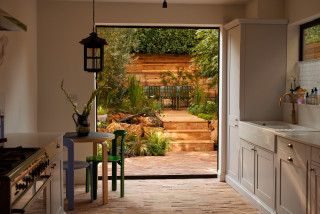The plantings at the front of the space can also withstand hot summers without much or any watering. “It’s a really drought-tolerant planting scheme,” Clayton says.
Highlights include: a bee-friendly, pink-flowering ornamental oregano (Origanum laevigatum ‘Herrenhausen’, USDA zones 5 to 9; find your zone); a low-growing rosemary (Rosmarinus officinalis ‘Prostratus’, zones 8 to 11); yellow-flowered yarrow (Achillea ‘Terracotta’, zones 3 to 8); thistle-like sea holly (Eryngium bourgatii, zones 5 to 8), and Latin American fleabane (Erigeron karvinskianus, Zone 6), which forms daisy-like flowers. “[Latin American] fleabanes are great filler plants and really help to pull a scheme together,” Clayton says. “They grow anywhere, bees love them and they flower nine months of the year, pretty much.”
Further back is purple-flowering ‘Rozanne’ cranesbill (Geranium ‘Rozanne’, zones 4 to 9) and Hart’s tongue fern (Asplenium scolopendrium, zones 5 to 9).
Amid the new foliage are existing shrubs and trees, including a large fig on the right and a Photinia that Clayton strategically reshaped. “The couple had quite a few large shrubs that were taking over the view and adding a lot of shade,” she says. “To be sustainable, we kept a lot of them but pruned them into multi-stems to make them lighter and also to let more daylight through. It’s nice, rather than just ripping everything out, and also gives you an opportunity to underplant them rather than just having dense shrubs,” the designer adds.
There was also an existing olive tree on the left. “The olive tree is massive,” Clayton says. “We love keeping bigger trees in the [landscape], and they give a sense of scale that helps to make a city garden feel more natural. I always think that going bigger with a couple of strong elements makes smaller spaces — weirdly — feel bigger.”
15 Ways to Create a Beautiful Water-Wise Landscape

Highlights include: a bee-friendly, pink-flowering ornamental oregano (Origanum laevigatum ‘Herrenhausen’, USDA zones 5 to 9; find your zone); a low-growing rosemary (Rosmarinus officinalis ‘Prostratus’, zones 8 to 11); yellow-flowered yarrow (Achillea ‘Terracotta’, zones 3 to 8); thistle-like sea holly (Eryngium bourgatii, zones 5 to 8), and Latin American fleabane (Erigeron karvinskianus, Zone 6), which forms daisy-like flowers. “[Latin American] fleabanes are great filler plants and really help to pull a scheme together,” Clayton says. “They grow anywhere, bees love them and they flower nine months of the year, pretty much.”
Further back is purple-flowering ‘Rozanne’ cranesbill (Geranium ‘Rozanne’, zones 4 to 9) and Hart’s tongue fern (Asplenium scolopendrium, zones 5 to 9).
Amid the new foliage are existing shrubs and trees, including a large fig on the right and a Photinia that Clayton strategically reshaped. “The couple had quite a few large shrubs that were taking over the view and adding a lot of shade,” she says. “To be sustainable, we kept a lot of them but pruned them into multi-stems to make them lighter and also to let more daylight through. It’s nice, rather than just ripping everything out, and also gives you an opportunity to underplant them rather than just having dense shrubs,” the designer adds.
There was also an existing olive tree on the left. “The olive tree is massive,” Clayton says. “We love keeping bigger trees in the [landscape], and they give a sense of scale that helps to make a city garden feel more natural. I always think that going bigger with a couple of strong elements makes smaller spaces — weirdly — feel bigger.”
15 Ways to Create a Beautiful Water-Wise Landscape